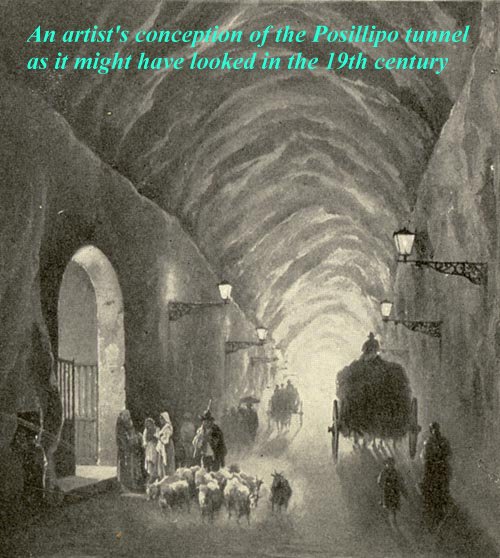Crypta Napoletana
Today, we visit the Philegraean Fields. The University of Houston's College of Engineering presents this series about the machines that make our civilization run, and the people whose ingenuity created them.
Benson Bobrick begins his fine book Labyrinths of Iron with a chapter on the Phlegraean Fields. That's hardly an obvious place to start this book, which tells the history of subways. The Phlegraean Fields are a region of hot springs and smoldering geothermal activity just west of Naples -- a lovely tourist attraction now, as it was in the first century BC. But there's a problem:
Between Naples and the Phlegraean Fields, Posillipo Hill runs down to the sea, separating the city from the Fields. Octavianus Caesar and his deputy Agrippa hired the engineer Cocceius to build three tunnels: two under Posillipo Hill and a third for naval access on the other side of the Fields. So build them he did.
Cocceius cut tunnels nearly a kilometer long through the volcanic tuff that'd been formed when old volcanic ash solidified. Their cross-sections were roughly 15 feet square with long ventilation shafts linking each to the surface.
The tunnels were meant for foot traffic, though they could ac-commodate horses and oxen as well. These truly were ancient subways. After some sixty years of use, one of the two under Posillipo Hill was reserved for the aristocracy and the other for commoners. Naturally there was a huge difference in maintenance. The commoner's tunnel was soon infested with filth and thieves.
The aristocrat's tunnel collapsed after four centuries. And, while the other survived, it was largely forgotten during the Middle Ages. Then a classic revival followed Dante's writings. Dante's hell reflected the Hades of Orpheus or Virgil. The Posillipo tunnel and the Phlegrean Fields were all of piece. Now we had a portal to the smoldering regions of Dante's hell.
The idea of an underworld had been deeply engraved in Egyptian, Chinese, Hebrew, and Roman thinking. They all dug tunnels; so, while Rome's were very grand, they weren't unique. And all that tunneling was linked to the mythologies of the nether regions.
That imagery was revived in the Renaissance, so engineers went back into Posillipo tunnel to make it even grander than it had been. At one time the renewed passageway was over fifty feet high. And people reveled in its sinister overtones. Christopher Marlowe's version of the Faust story includes a section where Satan shows the tunnel to Faust, and takes credit for it. And we begin to see Bobrick's intent. The history of tunneling is always interwoven with our sense that something not-of-this-world awaits us when we penetrate Earth's skin. Whether we explore a cave or catch a subway train, we never do quite shut out the memory of Orpheus, or of the Sybil telling Aeneas,
... The way to Avernus is easy;
Night and day lie open the gates of death's dark kingdom:
But to retrace your steps, to find the way back to daylight --
That is the task, the hard thing.
I'm John Lienhard, at the University of Houston, where we're interested in the way inventive minds work.
B. Bobrick, Labyrinths of Iron. (New York: Henry Holt and Company, 1981/1994): Chapter 1. (Bobrick includes the Sybil quote on page 25.)
See also: http://www.unesco.org/archi2000/pdf/viggiani2.pdf
J. L. Stoddard, John L. Stoddard's Lectures. Vol. VIII (Boston: Balch Brothers Co. MCMIII) pp. 115-126. Both images below are from Stoddard.
For more on tunnels and their relation to the mythic underworld, see EnginesEpisodes 849, 850, 994, 1198, 1388, and 1966.

